
Original: Arthur Hayes
Translation: Yuliya, PANews
Within the global central banking community, Jerome Powell and Haruhiko Kuroda have established a deep friendship. Since Kuroda stepped down as the Governor of the Bank of Japan (BOJ) a few years ago, Powell has frequently sought his advice or engaged in casual conversations. In early March of this year, a meeting between Powell and the new U.S. Treasury Secretary Scott Basset left him deeply troubled. This meeting left a psychological shadow on him, prompting him to seek someone to confide in. One can imagine:
In a conversation, Powell confided his troubles to Kuroda. Through their discussion, Kuroda recommended the "Jung Center," which specializes in serving central bank governors. This institution originated during the era of the Imperial Bank of Germany and was founded by the renowned psychologist Carl Jung, aimed at helping top central bankers cope with stress. After World War II, this service expanded to London, Paris, Tokyo, and New York.
The next day, Powell visited the office of psychologist Justin at 740 Park Avenue. There, he underwent an in-depth psychological consultation. Justin keenly observed that Powell was facing a dilemma of "fiscal dominance." During the consultation, Powell revealed the humiliating experience he had during his meeting with Secretary Basset, which severely impacted his self-esteem as the Chairman of the Federal Reserve.
Justin comforted him by saying that this situation was not unprecedented. She suggested that Powell read Arthur Burns' speech "The Dilemma of Central Banking" to help him understand and accept the situation.
In the latest meeting in March, Federal Reserve Chairman Powell hinted that quantitative easing (QE) might soon be reinstated, with a focus on the U.S. Treasury market. This statement marks a significant shift in the global dollar liquidity landscape. Powell outlined a possible path for this policy shift, which is expected to begin implementation as early as this summer. Meanwhile, although the market continues to debate the pros and cons of tariff policies, this could be positive news for the cryptocurrency market.
This article will focus on the political, mathematical, and philosophical reasons behind Powell's concession. It will first discuss President Trump's consistent campaign promises and why this mathematically necessitates the Federal Reserve and the U.S. commercial banking system to print money to purchase Treasury bonds. Then, it will explore why the Federal Reserve has never had the opportunity to maintain sufficiently tight monetary conditions to reduce inflation.
Commitment Made, Must Be Fulfilled
Recently, macroeconomic analysts have been discussing Trump's policy intentions. Some believe that Trump may adopt aggressive strategies until his approval rating falls below 30%; others think that his goal in his final term is to reshape the world order and reform America's financial, political, and military systems. In short, he is willing to tolerate significant economic pain and a drop in approval ratings to achieve policies he believes are beneficial for the U.S.
However, for investors, the key is to abandon subjective judgments about the "rightness or wrongness" of policies and instead focus on probabilities and mathematical models. The performance of a portfolio depends more on changes in global fiat currency liquidity than on the relative strength of the U.S. compared to other countries. Therefore, rather than trying to guess Trump's policy inclinations, it is better to focus on relevant data charts and mathematical relationships to better grasp market trends.
Since 2016, Trump has consistently emphasized that the U.S. has been treated unfairly due to trade partners taking advantage over the past few decades. Although there is controversy over his policy implementation, his core intentions have remained unchanged. On the Democratic side, while their statements on adjusting the global order are not as strong as Trump's, they generally agree with this direction. Biden has continued Trump's policies of restricting China’s access to semiconductors and other key areas of the U.S. market during his presidency. Vice President Kamala Harris also used tough rhetoric against China during her previous presidential campaign. Although there may be differences between the two parties in terms of the pace and depth of implementation, they share a unified stance in pushing for change.
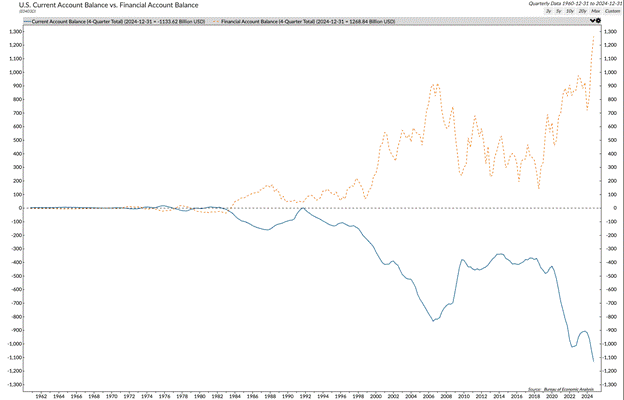
The blue line represents the U.S. current account balance, essentially the trade balance. It can be seen that since the mid-1990s, the U.S. has been importing far more goods than it exports, a trend that accelerated after 2000. What happened during this period? The answer is the rise of China.
In 1994, China significantly devalued the yuan and began its journey as a mercantilist export powerhouse. In 2001, U.S. President Bill Clinton allowed China to join the World Trade Organization, drastically reducing tariffs on Chinese exports to the U.S. As a result, the U.S. manufacturing base shifted to China, changing the course of history.
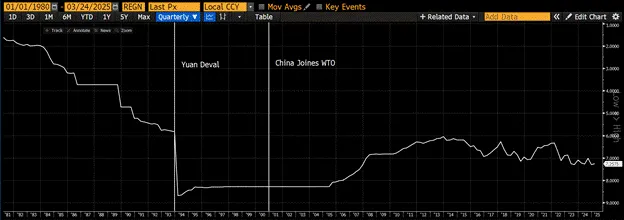
Trump's supporters are precisely those who have been negatively affected by the outsourcing of U.S. manufacturing jobs. These individuals typically do not have college degrees, live in the American heartland, and possess little to no financial assets. Hillary Clinton referred to them as "deplorables." Vice President JD Vance affectionately calls them and himself "hillbillies."
The orange dashed line and the upper panel in the chart represent the U.S. financial account balance. It can be seen that it is almost a mirror image of the current account balance. The reason China and other exporting countries can continue to accumulate massive trade surpluses is that when they earn dollars by selling goods to the U.S., they do not reinvest those dollars back into their domestic markets. Doing so would mean selling dollars to buy their own currencies, such as the yuan, leading to an appreciation of their currencies and thus increasing the prices of their exported goods. Instead, they use those dollars to purchase U.S. Treasury bonds and U.S. stocks. This allows the U.S. to maintain a large deficit without disrupting the Treasury bond market and to have the best-performing stock market globally over the past few decades.
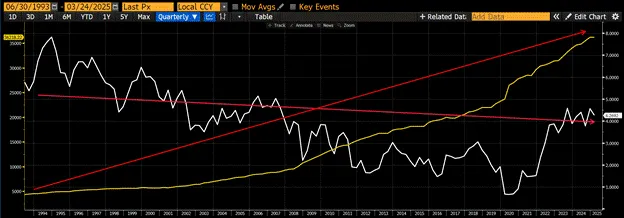
The yield on the U.S. 10-year Treasury bond (white) has slightly decreased, while the total outstanding debt (yellow) has increased sevenfold.
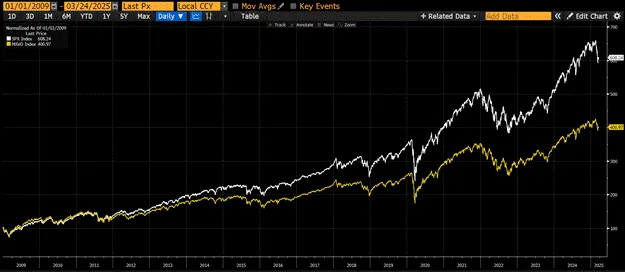
Since 2009, the MSCI U.S. Index (white) has outperformed the MSCI Global Index (yellow) by 200%.
Trump believes that by bringing manufacturing jobs back to the U.S., he can provide good jobs for about 65% of the population without college degrees, strengthen military power (as weapons, etc., will be produced in sufficient quantities to counter equal or near-equal adversaries), and achieve economic growth above trend levels, such as reaching 3% real GDP growth.
This plan has some obvious issues:
First, if China and other countries do not have dollars to support the Treasury and stock markets, prices will fall. U.S. Treasury Secretary Scott Basset needs buyers to purchase the massive debt that must be rolled over and the ongoing federal deficits. His plan is to reduce the deficit from about 7% to 3% by 2028.
The second issue is that capital gains taxes from rising stock markets are a marginal revenue driver for the government. When the wealthy cannot make money from stock trading, the deficit will increase. Trump's campaign platform is not to stop military spending or cut welfare programs like healthcare and social security, but to grow and eliminate fraudulent spending. Therefore, he needs capital gains tax revenue, even though the wealthy own all the stocks, and on average, they did not vote for him in 2024.
The Mathematical Dilemma of Debt Growth and Economic Growth
Assuming Trump successfully reduces the deficit from 7% to 3% by 2028, the government will still be a net borrower year after year, unable to repay any existing debt stock. From a mathematical perspective, this means that interest payments will continue to grow exponentially.
This sounds dire, but mathematically, the U.S. can escape the problem and deleverage its balance sheet through growth. If real GDP growth is 3% and long-term inflation is 2% (though unlikely), this means nominal GDP growth is 5%. If the government issues debt at a rate of 3% of GDP, but the nominal growth rate of the economy is 5%, then mathematically, the debt-to-GDP ratio will decline over time. However, a key factor is missing: at what rate can the government finance itself?
Theoretically, if the U.S. economy grows nominally at 5%, Treasury bond investors should demand at least a 5% return. But this would significantly increase interest costs, as the current weighted average interest rate on the Treasury's approximately $36 trillion (and growing) debt is 3.282%.
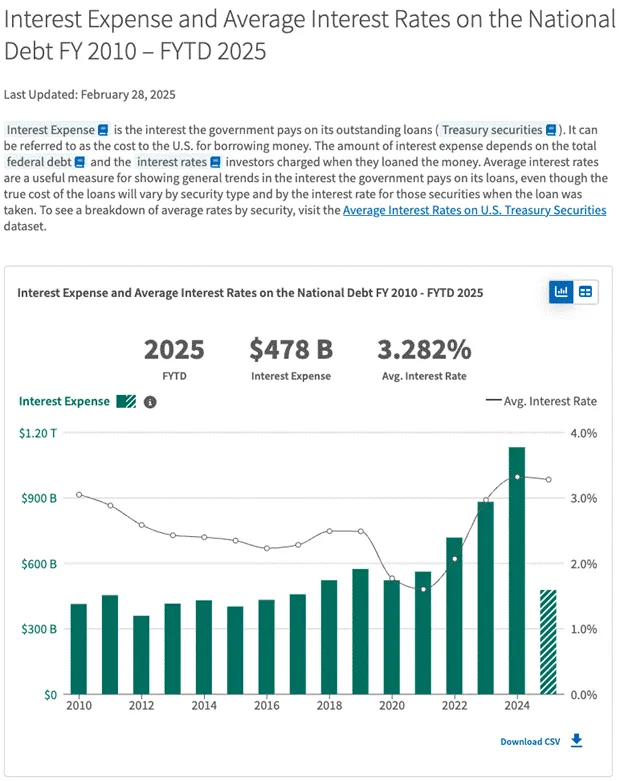
Unless Basset can find buyers willing to purchase Treasury bonds at unreasonably high prices or low yields, the mathematical calculations cannot hold. As Trump is busy reshaping the global financial and trade system, China and other exporting countries cannot and will not buy Treasury bonds. Private investors also will not, as the yields are too low. Only U.S. commercial banks and the Federal Reserve have the firepower to purchase debt at levels the government can afford.
The Federal Reserve can print money to buy bonds, a process known as quantitative easing (QE). Banks can print money to buy bonds, known as fractional reserve banking. However, the actual operation is not that simple.
The Federal Reserve is ostensibly busy with its unrealistic task of bringing manipulated and false inflation indicators down below their fictitious 2% target. They are removing money/credit from the system through balance sheet reduction, known as quantitative tightening (QT). Due to poor performance during the 2008 global financial crisis (GFC), regulators have required banks to pledge more of their own capital against the Treasury bonds they purchase, known as the supplementary leverage ratio (SLR). Therefore, banks cannot use unlimited leverage to finance the government.
However, changing this situation and transforming the Federal Reserve and banks into inelastic buyers of Treasury bonds is quite simple. The Federal Reserve can decide to at least end quantitative tightening and maximize the restart of QE. The Federal Reserve can also exempt banks from complying with SLR, allowing them to use unlimited leverage to purchase Treasury bonds.
The question becomes why the Federal Reserve, led by Jerome Powell, would help Trump achieve his policy goals. The Fed clearly aided Harris's campaign by lowering interest rates by 0.5% in September 2024, and after Trump's victory, it stubbornly responded to Trump's demands to increase the money supply to lower long-term Treasury yields. To understand why Powell would ultimately do what the government asks of him, one may trace back to the historical context of 1979.
The Disempowered Chairman
Now, Powell finds himself in a very awkward position, watching as the dominant force of fiscal policy undermines the Fed's credibility in fighting inflation.
Simply put, when government debt is too large, the Fed has to abandon its independence to finance the government at low interest rates rather than genuinely combat inflation.
This is not a new problem. Former Fed Chairman Burns faced a similar situation in the 1970s. In his 1979 speech "The Pain of Central Banking," he explained why central banks struggle to control inflation:
"Since the 1930s, political and philosophical currents in the U.S. and elsewhere have changed economic life, creating a persistent tendency toward inflation."
In simple terms: Politicians made me do it.
Burns pointed out that the government became increasingly interventionist in the economy, not only providing relief for the suffering but also subsidizing "worthy" activities and restricting "harmful" competition. Despite the growth of national wealth, American society was tumultuous in the 1960s. Minority groups, the poor, the elderly, and the disabled felt injustice, and young people in the middle class began to reject existing institutions and cultural values. Just as now, "prosperity" was not evenly distributed, and people demanded the government address this issue.
The interaction between government actions and public demands escalated continuously. When the government began addressing "unfinished tasks" like reducing unemployment and eliminating poverty in the mid-1960s, it awakened new expectations and demands.
Now, Powell faces a similar dilemma, wanting to be a tough anti-inflation hero like Volcker, but in reality, he may be forced to yield to political pressure like Burns.
The history of government intervention attempting to address key voter group issues stretches back decades. The actual effects of such interventions often vary by circumstance, and the outcomes are not always the same.
Many results generated by the active interaction between the government and citizens have indeed had positive impacts. However, the cumulative effect of these actions has injected a strong inflationary tendency into the U.S. economy. The surge in government programs has gradually increased the tax burden on individuals and businesses. Even so, the government's willingness to tax is clearly lower than its propensity to spend.
A general consensus has formed in society: solving problems is the government's responsibility. The primary way the government addresses problems is by increasing spending, a practice that deeply embeds inflationary factors into the economic system.
In reality, the expansion of government spending is largely driven by a commitment to full employment. Inflation has gradually been widely viewed as a temporary phenomenon—or, as long as it remains moderate, an acceptable state.
The Fed's Tolerance for Inflation and Policy Contradictions
Why does the Fed tolerate 2% inflation each year? Why does the Fed use terms like "transitory" inflation? A 2% inflation compounded over 30 years will lead to an 82% increase in price levels. But if the unemployment rate rises by 1%, the sky is falling. These are worth pondering.
Theoretically, the Fed system had the capacity to snuff out inflation in its infancy or terminate it at any subsequent point. It could have restricted the money supply, creating enough tension in financial and industrial markets to swiftly end inflation. However, the Fed has not taken such actions because it is also influenced by the philosophical and political currents that change American life and culture.
The Fed ostensibly maintains independence, but as a government institution philosophically inclined to address broad social issues, it neither can nor will stop the inflation that requires intervention. The Fed has effectively become a facilitator, creating the inflation it was supposed to control.
Faced with political realities, the Fed has indeed adopted tight monetary policies at certain times—such as in 1966, 1969, and 1974—but its restrictive stance has not lasted long enough to completely end inflation. Overall, monetary policy has begun to be governed by the principle of "nurturing the inflation process at a low level while still accommodating most market pressures."
This is precisely the path taken by Powell during his tenure as Fed Chairman. It reflects the so-called "fiscal dominance" phenomenon. The Fed will take necessary measures to support government funding. The merits of policy goals can be viewed differently, but the message conveyed by Burns is clear: when one becomes the Fed Chairman, one implicitly agrees to do whatever is necessary to ensure the government can finance itself at an affordable level.
Current Policy Shift
Powell has shown signs of the Fed continuing to yield to political pressure in a recent press conference. He had to explain why, despite strong economic indicators and loose monetary conditions in the U.S., the pace of quantitative tightening (QT) would be slowed. The current low unemployment rate, historical highs in the stock market, and inflation still above the 2% target should support a tighter monetary policy.
Reuters reported: "The Fed said on Wednesday that starting next month, it will slow the pace of its balance sheet reduction, as the issue of government borrowing limits remains unresolved, a shift that may continue for the remainder of the process."
According to historical records from the Fed, although former Fed Chairman Paul Volcker was known for his strict monetary policy, he chose to ease policy in the summer of 1982 when faced with economic recession and political pressure. At that time, House Majority Leader James C. Wright Jr. met with Volcker multiple times to try to make him understand the impact of high interest rates on the economy, but to no significant effect. However, by July 1982, data showed that the economic recession had bottomed out. Volcker then told Congress members that he would abandon the previously set goal of tight monetary policy and predicted a "highly likely" economic recovery in the second half of the year. This decision also echoed the Reagan administration's long-standing expectations for recovery. Notably, although Volcker is regarded as one of the most respected Fed Chairmen, he also could not fully withstand political pressure. At that time, the U.S. government's debt situation was far better than it is now, with debt-to-GDP ratios of only 30%, whereas now it has reached 130%.
Evidence of Fiscal Dominance
Last week, Powell proved that fiscal dominance still exists. Therefore, in the short to medium term, QT targeting Treasury bonds will stop. Furthermore, Powell stated that while the Fed may maintain the natural reduction of mortgage-backed securities (MBS), it will net buy Treasury bonds. Mathematically, this keeps the Fed's balance sheet constant; however, it is effectively quantitative easing for Treasury bonds. Once officially announced, Bitcoin prices will surge significantly.
Additionally, due to the demands of banks and the Treasury, the Fed will provide SLR exemptions for banks, which is another form of quantitative easing for Treasury bonds. The ultimate reason is that the aforementioned mathematical calculations would otherwise not work, and Powell cannot stand by and let the U.S. government fall into trouble, even if he dislikes Trump.
Powell mentioned the balance sheet adjustment plan during the FOMC press conference on March 19. He stated that the Fed would stop the net reduction of assets at some point, but no related decision has been made yet. At the same time, he emphasized the hope to gradually let MBS exit the Fed's balance sheet in the future. However, he also mentioned that the Fed might allow MBS to naturally mature while keeping the overall balance sheet size unchanged. The specific timing and manner of these adjustments have yet to be determined.
Treasury Secretary Basset discussed the supplementary leverage ratio (SLR) in a recent podcast, noting that if SLR were to be eliminated, this policy could become a constraint for banks and could lead to a decline in U.S. Treasury yields by 30 to 70 basis points. He pointed out that each basis point change equates to about $1 billion in economic impact annually.
Moreover, Fed Chairman Powell stated in the press conference following the March FOMC meeting that regarding the inflation effects potentially brought about by the tariff policies proposed by the Trump administration, he believes that such inflation effects may be "transitory." He noted that while tariffs may trigger inflation, this impact is expected not to last long. This judgment of "transitory" inflation allows the Fed to continue adopting accommodative policies in the face of inflation triggered by tariff increases. Powell pointed out that the current baseline view is that the price-driving effect of tariffs will not persist in the long term, but he also emphasized that future situations remain uncertain. Analysts believe this statement implies that the impact of tariffs on asset prices may be diminishing, especially for those assets that rely solely on fiat liquidity.
Fed Chairman Powell stated at the March FOMC meeting that the inflation effects triggered by tariffs may be "transitory." He believes that this "transitory" inflation expectation allows the Fed to continue implementing accommodative policies even in the face of significant inflation due to tariffs.
In the post-meeting press conference, Powell emphasized that the current basic expectation is that the price increases caused by tariffs will be temporary, but he also added, "We cannot determine the specifics of future situations." Market analysts pointed out that for assets relying on fiat liquidity, the impact of tariffs may have gradually diminished.
Additionally, the "Liberation Day" that Trump plans to announce on April 2 and the potential tariff increases seem to have had no significant impact on market expectations.
Dollar Liquidity Calculations
It is important to consider the changes in forward-looking dollar liquidity relative to previous expectations.
Previous pace of Treasury bond quantitative tightening (QT): $25 billion reduction per month
Post-April 1 pace of Treasury bond QT: $5 billion reduction per month
Net effect: Positive change in dollar liquidity of $240 billion annualized
Effect of reversing QT: Up to $35 billion reduction in MBS per month
If the Fed's balance sheet remains unchanged, it can purchase: Up to $35 billion in Treasury bonds per month or $420 billion annualized
Starting from April 1, an additional $240 billion of relative dollar liquidity will be created. In the near future, by the latest in the third quarter of this year, this $240 billion will rise to an annualized $420 billion. Once quantitative easing begins, it will not stop for a long time; as the economy requires more money printing to maintain the status quo, it will increase.
How the Treasury manages its General Account (TGA) is also an important factor affecting dollar liquidity. The TGA is currently about $360 billion, down from about $750 billion at the beginning of the year. Due to debt ceiling constraints, the TGA is used to maintain government spending.
Traditionally, once the debt ceiling is raised, the TGA will be refilled, which poses a negative impact on dollar liquidity. However, maintaining excessively high cash balances is not always economically rational; during former Treasury Secretary Yellen's tenure, the target TGA balance was set at $850 billion.
Considering that the Fed can provide liquidity support as needed, the Treasury may adopt a more flexible TGA management strategy. Analysts expect that in the quarterly refinancing announcement (QRA) in early May, the Treasury may not significantly increase the target TGA balance relative to current levels. This will mitigate the potential negative dollar liquidity shock that may arise after raising the debt ceiling, providing a more stable environment for the market.
Case Study of the 2008 Financial Crisis
During the 2008 Global Financial Crisis (GFC), gold and the S&P 500 exhibited different responses to the increase in fiat currency liquidity. Gold, as an anti-establishment commodity financial asset, reacted more quickly to liquidity injections, while the S&P 500, relying on the legal support of the national system, may have responded more slowly in situations where the solvency of the economic system was questioned. Data shows that during the most severe phases of the crisis and the subsequent recovery period, gold outperformed the S&P 500. This case study indicates that even with a significant increase in current dollar liquidity, a negative economic environment may still adversely affect the price trends of Bitcoin and cryptocurrencies.
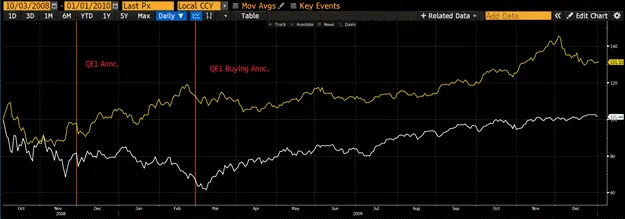
On October 3, 2008, the U.S. government announced the launch of the Troubled Asset Relief Program (TARP) to address the market turmoil triggered by the bankruptcy of Lehman Brothers. However, the program failed to stop the continued decline of financial markets, with both gold and U.S. stocks falling. Subsequently, Fed Chairman Ben Bernanke announced the initiation of a large-scale asset purchase program (later known as Quantitative Easing 1, or QE1) in early December 2008. As a result, gold began to rebound, while U.S. stocks continued to decline until the Fed officially started its money-printing actions in March 2009. By early 2010, the price of gold had risen by 30% compared to the time of Lehman Brothers' bankruptcy, while U.S. stocks had only increased by 1% during the same period.
Bitcoin Value Equation
Bitcoin did not exist during the 2008 financial crisis, but it has now become an important financial asset. The value of Bitcoin can be simplified as:
Bitcoin Value = Technology + Fiat Currency Liquidity
The technology behind Bitcoin is functioning well, with no significant changes recently, whether good or bad. Therefore, Bitcoin's trading is entirely based on market expectations of future fiat currency supply. If the analysis of the Fed's significant shift from quantitative tightening to quantitative easing for Treasury bonds is correct, then Bitcoin's recent local low of $76,500 last month will begin to rise towards the year-end target of $250,000. Although this prediction is not a precise scientific conclusion, referencing gold's performance patterns in similar environments, Bitcoin is more likely to reach $110,000 first rather than revisit $76,500. Even if the U.S. stock market continues to decline due to tariff policies, collapsing corporate earnings expectations, or weakened foreign demand, Bitcoin still has a significant chance of continuing to rise. Investors should cautiously deploy funds, avoid using leverage, and purchase small positions relative to the total size of their portfolios.
However, Bitcoin still has the potential to reach $250,000 by the end of the year. This optimistic expectation is based on multiple factors, including the Fed potentially driving the market by releasing liquidity, and the People's Bank of China possibly easing monetary policy to maintain the stability of the renminbi against the dollar. Additionally, European countries may increase military spending due to security concerns, which could be achieved through printing euros, potentially stimulating market liquidity indirectly.
免责声明:本文章仅代表作者个人观点,不代表本平台的立场和观点。本文章仅供信息分享,不构成对任何人的任何投资建议。用户与作者之间的任何争议,与本平台无关。如网页中刊载的文章或图片涉及侵权,请提供相关的权利证明和身份证明发送邮件到support@aicoin.com,本平台相关工作人员将会进行核查。




